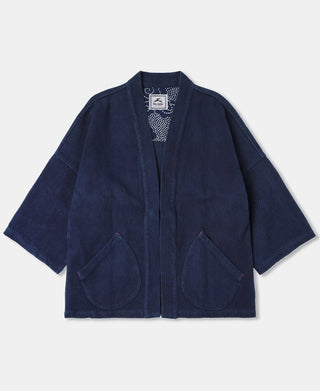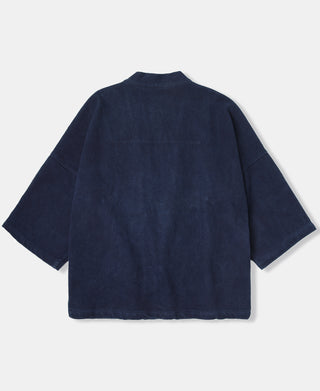Save 5% on your first order. Click Here
Save 5% on your first order. Click Here
Free Shipping over £79 + 30-day Returns.
Model
Adding product to your cart
Inspired by vintage Japanese Sashiko Kendo Jacket. Made of sashiko cotton with a texturized, woven handle, heavyweight 550 GSM. Hand-dyed using natural indigo and washed.
**Model - 5' 10", 159lbs / 178cm, 72.5kg. Size M.**
Please use this info as a general guide as measurements are approximate.
| Size | Shoulder | Chest |
| M | Free | 43.3" / 110 cm |
| L | Free | 47.2" / 120 cm |
| XL | Free | 51.2" / 130 cm |
| XXL | Free | 55.1" / 140 cm |
| Size | Length |
| M | 26.4" / 67 cm |
| L | 27.6" / 70 cm |
| XL | 29.1" / 74 cm |
| XXL | 30.7" / 78 cm |
In order to best determine fit, it may be helpful to compare our garment’s measurements to a similar garment you already own. Lay your garment on a flat surface and take all measurements from the outside of the garment.
Click here to check out our Garment Measuring Guide.
** If you are still confused, you can Contact Us to help you choose the size. **
Inspired by vintage Japanese Sashiko Kendo Jacket. Made of sashiko cotton with a texturized, woven handle, heavyweight 550 GSM. Hand-dyed using natural indigo and washed.
**Model - 5' 10", 159lbs / 178cm, 72.5kg. Size M.**
Please use this info as a general guide as measurements are approximate.
| Size | Shoulder | Chest |
| M | Free | 43.3" / 110 cm |
| L | Free | 47.2" / 120 cm |
| XL | Free | 51.2" / 130 cm |
| XXL | Free | 55.1" / 140 cm |
| Size | Length |
| M | 26.4" / 67 cm |
| L | 27.6" / 70 cm |
| XL | 29.1" / 74 cm |
| XXL | 30.7" / 78 cm |
In order to best determine fit, it may be helpful to compare our garment’s measurements to a similar garment you already own. Lay your garment on a flat surface and take all measurements from the outside of the garment.
Click here to check out our Garment Measuring Guide.
** If you are still confused, you can Contact Us to help you choose the size. **
Sashiko (刺し子, lit. 'little stabs') is a type of traditional Japanese embroidery or stitching used for the decorative and/or functional reinforcement of cloth and clothing.
First coming into existence in the Edo period (1603–1867), sashiko embroidery was first applied to clothing out of a practical need and would have been used to strengthen the homespun clothes of olden times. Worn-out clothes were pieced together to make new garments by using simple running stitches. These clothes increased their strength with this durable embroidery. By the Meiji period (1868–1912), sashiko had been established enough to evolve into winter work in northern farming communities when it was too cold to work outside.
Sashiko was commonly used to reinforce already-patched clothing around points of wear, but it would also be used to attach patches to clothing, ultimately making the fabric stronger. It would also be used to layer thin fabrics to create warmth and, in the case of some garments such as the coats of firemen, to create a thick and absorbent material that would be soaked in water before carrying out duties as a fireman. Though most sashiko utilizes only a plain running stitch technique, sashiko is commonly used to create decorative and repeated embroidered patterns and may be used for purely decorative purposes, such as in the creation of quilts and embroidery samplers.








